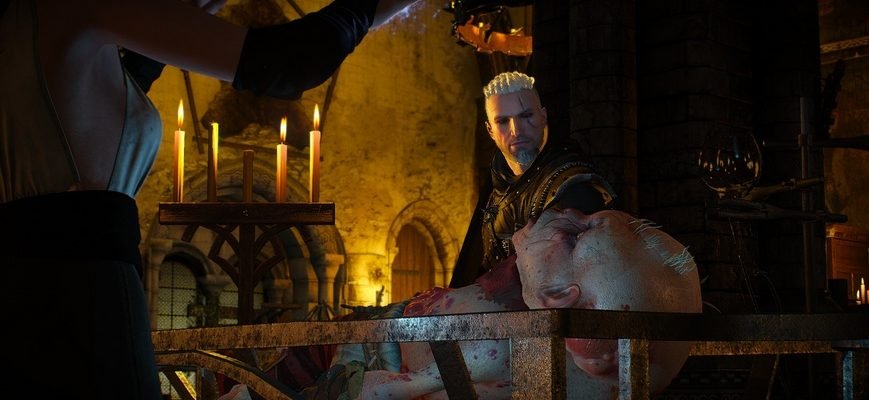In “The Witcher 3: Wild Hunt,” the quest “Va Fail, Elaine” features a significant event known as the Trial of the Grasses. This process is a transformative and often perilous ritual that witchers undergo to mutate into powerful monster hunters. During this particular quest, Geralt and Yennefer administer this trial to Uma in a desperate attempt to dispel the curse wrapped around the creature’s true identity. As players navigate through this intense session, one question frequently arises: does the order of administering the potions impact the outcome, and if so, in what order should the valves be opened?
The Context of the Trial of the Grasses
The Trial of the Grasses in “The Witcher 3” harkens back to one of the series’ most enduring motifs: transformation through pain and endurance. In the game, this trial is typically performed on young boys aspiring to become witchers, a process fraught with high mortality rates. In the quest concerning Uma, the trial serves a unique purpose, aimed at revealing the creature’s concealed identity rather than imbuing Uma with supernatural abilities.
Uma’s curse poses a profound mystery, and the characters involved — Geralt, Yennefer, and the other witchers at Kaer Morhen — realize that the only feasible way to lift it involves revisiting this ancient trial. Despite the risk and potential for unforeseen consequences, they undergo the procedure, turning to Yennefer’s expertise with a mixture of apprehension and resolve.
Understanding the Potions
During this quest, Geralt must administer three crucial potions to Uma, each represented by distinct IV bottles: Wildrye Juice, Speargrass Sap, and Mother’s Tears. While Yen indicates that the order doesn’t technically matter, the quest stokes curiosity and debate among players about whether there is a subtle, game-influencing sequence to follow. Let’s explore the potential significance of each potion within the alchemical lore and gameplay.
- Wildrye Juice: Known for its soothing properties, Wildrye Juice could symbolize the preparatory easing of Uma into the trial.
- Speargrass Sap: With its invigorating characteristics, Speargrass Sap may represent the main transformative agent, potentially the pivot of the ritual.
- Mother’s Tears: This potion is believed to stabilize or soothe, correlating to pain mitigation or calming during the intense process.
Each potion’s lore and alchemy imply a specific role in the physiological and magical transformation of the trial. Players must ponder these roles while operating under pressure, deciding which order might lead to an optimal outcome.
Examining Player Choices and Their Outcomes
Possible Sequences and Assessments
In analyzing various approaches to administering the potions, players debate sequences such as 2-3-1 or 2-1-3, engaging with potential hints drawn from the alchemy skill tree or other narrative elements. Here’s a detailed look at these sequences:
- Sequence 2-3-1 (Endure Pain, Fast Metabolism, Frenzy): This sequence aims to tackle the worst of the trial’s challenges upfront. Players believe that endearing the worst pain initially might better prepare Uma for the subsequent transformations.
- Sequence 2-1-3 (Endure Pain, Frenzy, Fast Metabolism): Here, the focus is on alternating between pain mitigation and fortification, suggesting a balanced yet dynamic approach.
- Sequence 3-1-2 (Fast Metabolism, Frenzy, Endure Pain): Advocates for this sequence argue it allows the ritual to harness Uma’s potential transformation energies earlier, capitalizing on the initial elixirs before rounding off with pain endurance.
While these sequences illustrate different rationales based on the potions’ purported properties, the game ultimately maintains a narrative structure where these choices are more about dramatic engagement rather than functional divergence in the quest’s outcome. Players frequently report back that while interactions and comments during the trial may vary slightly in dialogue or sentiment, the fundamental course — revealing Uma’s true form — remains consistent.
Dialogue Variations and Player Concerns
Throughout the trial, certain dialogue branches offer opportunities for players to engage with the story’s emotional depth and moral dilemmas. Players have tested responses like “Stop, this is a bad idea,” only to find Yennefer’s firm insistence and eventual dismissal from altering the sequence of events. These interactions enrich the narrative, adding layers of tension and moral ambiguity. They underscore the trial’s stakes and existential questions posed by Uma’s suffering and eventual revelation.
Importantly, dialogue choices during subsequent scenes with Yennefer—conversations such as the humorous “Dandy sword” story share or the reminiscing Ciri narrative—further glimpse into character dynamics but provide no mechanical alteration to the quest’s resolution. Instead, they help to connect players emotionally to the scenario while allowing them to leave a touch of personal imprint on Geralt’s narrative path.
Understanding Game Mechanics vs. Narrative Influence
While some players speculate over mechanical hidden effects or the possibility of ignoring the trial’s intended linearity, developers designed the sequence with a narrative-centric approach. Ultimately, interactions primarily aim at building suspense and immersion rather than altering the fixed outcome of the Trial of the Grasses. The sequence is an essential storytelling device rather than a branching gameplay path.
However, it’s the players’ attempts to explore emergent storytelling through these choices—attempts to halt the process or question Yennefer—that demonstrate how “The Witcher 3” successfully weaves player agency with robust narrative arcs. Each dialogue choice, though inconsequential to outcomes, matters to character development and contributes to the rich tapestry of storytelling.
The Unveiling and Its Consequences
Upon completing the potion sequence, the witchers and Yennefer set the stage for Uma’s transformation. It’s a tense moment that highlights the dedication and care they’ve invested into saving an individual cloaked in secrets and curses.
What follows is a poignant reveal: Uma’s identity is none other than Avallac’h, an elven Sage and central figure in the larger narrative surrounding Ciri and the Wild Hunt. This revelation recontextualizes the group’s journey and decisions up to this point, underscoring the impact their actions hold on the ongoing confrontation against the game’s primary antagonists.
The success of the Trial of the Grasses on Uma sets in motion subsequent events leading to Ciri’s rescue and the larger conflict. It serves as a pivotal point in the game, pushing players to further engage with the monstrous challenges and heartfelt triumphs defining the “Witcher” series.
Conclusion
The Trial of the Grasses in “The Witcher 3” eloquently combines narrative suspense with player agency, delivering an immersive experience that resonates deeply within the game’s lore. As players administer the potions without definitive gameplay repercussions, the sequence’s true purpose emerges: an exploration of character commitment and a reaffirmation of witcher ethics. Operating under the presumption of choice when the outcome is fixed becomes a narrative master stroke. Whether choosing 2-3-1 or another order, the core lessons remain steeped in the witchers’ creed of resilience, sacrifice, and unflinching duty.









